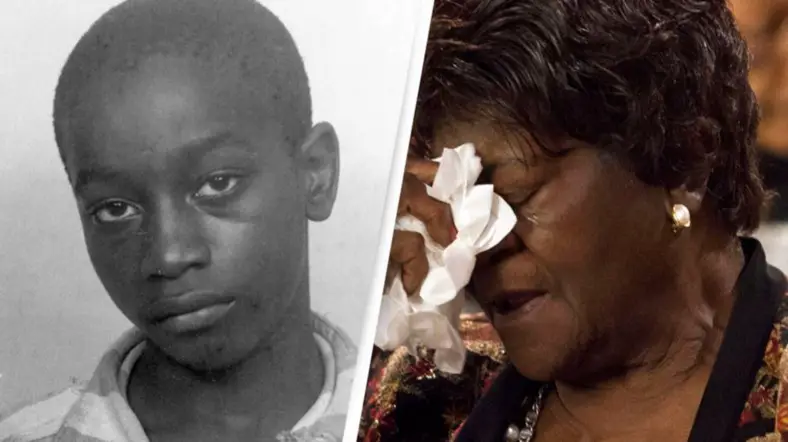 any people aren’t aware of George Junis Stinney Jr. as his tragic case had been overshadowed by World War II. In 1944 George was convicted of the murder of two young girls, Betty June Binnicker, age 11, and Mary Emma Thames, age 7, in his hometown of Alcolu, South Carolina.
any people aren’t aware of George Junis Stinney Jr. as his tragic case had been overshadowed by World War II. In 1944 George was convicted of the murder of two young girls, Betty June Binnicker, age 11, and Mary Emma Thames, age 7, in his hometown of Alcolu, South Carolina.
When the murder of the two girls took place, George and his brother Johnny were playing around the house. As police officers were not able to find any other suspects, they arrested George and his brother on the suspicion of murder, even if the boys were underage. The main reason the two boys were chosen by the police officers as suspects is because they identified as African Americas.
The 1940s were still seen as a terrible year for racial segregation, even if the world was still more worried about the war, they were still quite racist. Judge Carmen Mullen from South Carolina had looked into this case after more than 70 years to determine that the law was not respected in any single manner. When George was interrogated upon being arrested, he was alone and based on the law, any minor must be accompanied by a parent or guardian whilst being interrogated.
Unethical interrogations tactics were used to put fear into George and the right words in his mouth for the judge to find him “guilty” of something he didn’t do. Furthermore, his human rights were taken away as whilst being interrogated, the boy was not fed and wasn’t allowed to use the bathroom. The parents were also not allowed to speak with George which they had every right to based on US law.
The day of the trial was all planned beforehand. The jury was made up of only white people as it was normal for the time because African-American citizens were still prohibited to be jurors. The three officers who testified that George confessed were not even challenged by the judge, nor the prosecutors. The trial took less than 10 minutes and George was not given much of a chance, being sentenced to death by the electrical chair.
The most tragic part of this whole case is that George was tortured on the day of his execution as he didn’t die instantly as he should have by the electric chair. When the switch was flipped and the first 2,400 volts surged through his body, the too-large death mask slipped from his face revealing the tears falling from his scared, open eyes. A second and third charge followed. His death was actually concluded 8 minutes and 2 seconds after being shocked.
Judge Carmen Mullen with the help of Aime Ruffner who is George’s sister who was only eight years old when he was executed had fought to prove her brother’s innocents. Two other siblings came to help, another sister was known as Katherine Robinson who was 10 at the time, and Charles Stinney who was 12 years old.
The siblings have spoken about how their family was terrorized after George’s execution because everyone blamed them for the murder of the two young girls. They had to move from one place to another and barely make ends meet as their parents had to change jobs frequently. During George’s trial, his parents were only allowed to see him once based on what Aime said:
“My mother cried and prayed,” said Aime. “We wanted the truth to come out. But sometimes when you don’t have the means and the money you accept things for what they are. The NAACP [National Association for the Advancement of Coloured People] tried to stop it, but it was no use. In those days, when you are white you were right, when you were black you were wrong.” (Quote by Aime Ruffner)
Aime also said at the trial under the oath she had taken that George was home the whole day when the murder of the two girls took place, so it was impossible for him to be the criminal. Judge Carmen Mullen didn’t start a trial to determine whether George committed the crime or not, but to determine if George received a fair trial.
“No one can justify a 14-year-old child charged, tried, convicted and executed in some 80 days.” The injustices, she said, included a witness who discovered the victims’ bodies being allowed to sit on the coroner’s inquest; a trial that lasted less than a day; a state-appointed defence lawyer, Plowden, who did not call any witnesses, ask any questions on cross-examination, offered little or no defence and filed no appeal. Mullen concluded: “In essence, not much was done for this child when his life lay in the balance.” (Quote by Judge Carmen Mullen)
All the family once is some justice and peace of mind as they know their brother is innocent. Some may say that this action is irrelevant, but the importance of healing some of the family’s pain by bringing justice should justify this trial.
Avid Writer with invaluable knowledge of Humanity!
Upcoming historian with over 30 million views online.
“You make your own life.”





